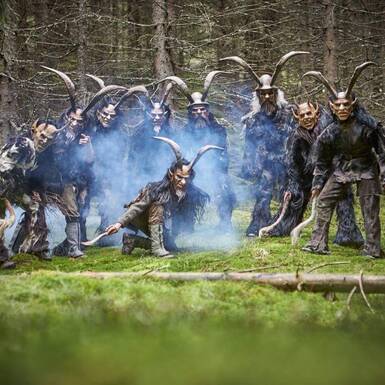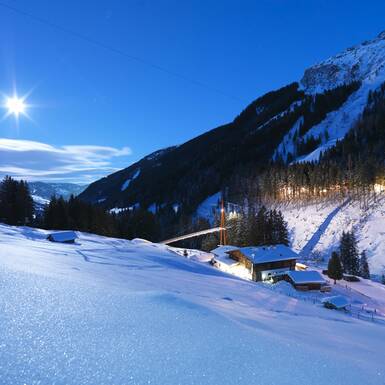- Traditions
Schnitza's crib workshop
Herbert “Schnitza” Aschaber, a wood artist from Hinterglemm, runs a wood carving workshop in which one of his passion projects is slowly coming to life. On behalf of the local community, he handcrafts the protagonists of the biblical search for shelter for the new village crib, which can be marvelled at starting early December in the Musikpavillion at the Saalbach village square.
Upon entering the wood workshop in the former underground car park of the Alpine Palace in Hinterglemm, I am received not only by the spicy scent of wood. Suddenly, “Schnitza’s” head emerges from among wood chips and stored logs, as he welcomes me to his creative hub with a heartfelt “Grias Di” (‘hi there’) and a firm handshake. His actual name is Herbert Aschaber, but everyone calls him “Schnitza” in Saalbach Hinterglemm. The name says it all, because Schnitza’s passion is wood (“Schnitza” is derived from “Schnitzer”, i.e. “wood carver”).
A real passion project!
During summer, he runs the naturalistic attraction site “Schnitza’s Holzpark” in the Talschluss valley head together with his wife. And a few years ago, the trained wood carver and his artistic companion Florian Breitfuß came together to create furnishings for hotels and businesses under the brand “GlemmArt”. The Saalbach Hinterglemm village crib, however, is a real passion project for Schnitza, who explains, „I have been wanting to make this crib for twenty years, but things only started moving ahead after the Holzsymposium some summers ago. I presented my sketches as well as a concept figure to the community and finally received the OK for this project which will take several years.”
Schnitza groups together the completed figures of Joseph and Mary with Baby Jesus for my camera in an almost reverent way and says, “The crib figures have not been designed in the baroque style on purpose and also don’t have faces. They give the parents a little freedom when it comes to telling their children the story of the search for shelter. And a lot more can be discovered upon closer inspection. Joseph and Mary, for example, were carved out of a single piece of stone pine wood. I used many different types of wood for Baby Jesus – hornbeam, pear and larch – because Jesus unites a lot of different ideas through his predestination. Other figures, however, are meant to surprise and provoke thought. Like the Star of Bethlehem. In our crib, it’s displayed during a later stage – as a burned out meteorite. I used driftwood from Italy in combination with parts of an old coffee table for the star.”
Crib scene with room for interpretation
Ox and donkey, the holy family, the shepherds with the shepherds’ child and the comet make up the first stage of the village crib, but the figure with the bright red shoes confuses me. Schnitza explains laughingly, “This is the ‘girl from the city’ – my own interpretation. You can tell the story of the search for shelter in a more conciliatory way: housing in Bethlehem was completely overcrowded due to the population census and nobody was able to take in the couple before they finally found refuge in a barn. This made the city dwellers feel bad, so they went to see if they could help. And that is why the girl from the city shows up in this crib as well. And later there is also an innkeeper who, as a conciliatory gesture, brings food to the barn. But what I really want is for people to think for themselves and interpret it in their own way – the crib tells its own story if you look close enough.”
Obelisks and the three kings
The mighty obelisk made from a single maple tree trunk, which Schnitza is currently working on and trimming with his chainsaw, is also going to be eye-catching. As the chainsaw screeches and sawdust flies, he says, “This is my personal highlight – an inscribed obelisk, as it was common in ancient Egypt to put laws into stone. Five world religions will be inscribed into this obelisk. And I’m not doing this for the sake of provocation. No matter which religion we belong to, it is our dedication to life that makes us who we are.” The creation of the Saalbach Hinterglemm village crib will take the artist several years. “The three kings, with their impressive following, are of course still missing. Naturally, there will also be a camel with them. As well as the angel of annunciation, sheep and the conciliatory innkeeper. It is my goal to give life to the crib and to get people to think about it. In many homes, the crib has become a mere piece of Christmas decoration that is pulled out of the box every year. I would like it if the figures wouldn’t just be stored somewhere in the dark after disassembly. It would be great if hotels and businesses could borrow the figures and exhibit them. Then all the figures could come back together again during the next Advent.”
So, from now on, all locals and visitors in Saalbach Hinterglemm will have to take a look at the new crib for Christmas! The village crib will be exhibited in the Musikpavillion at the village square in Saalbach from early December until 6 January.









